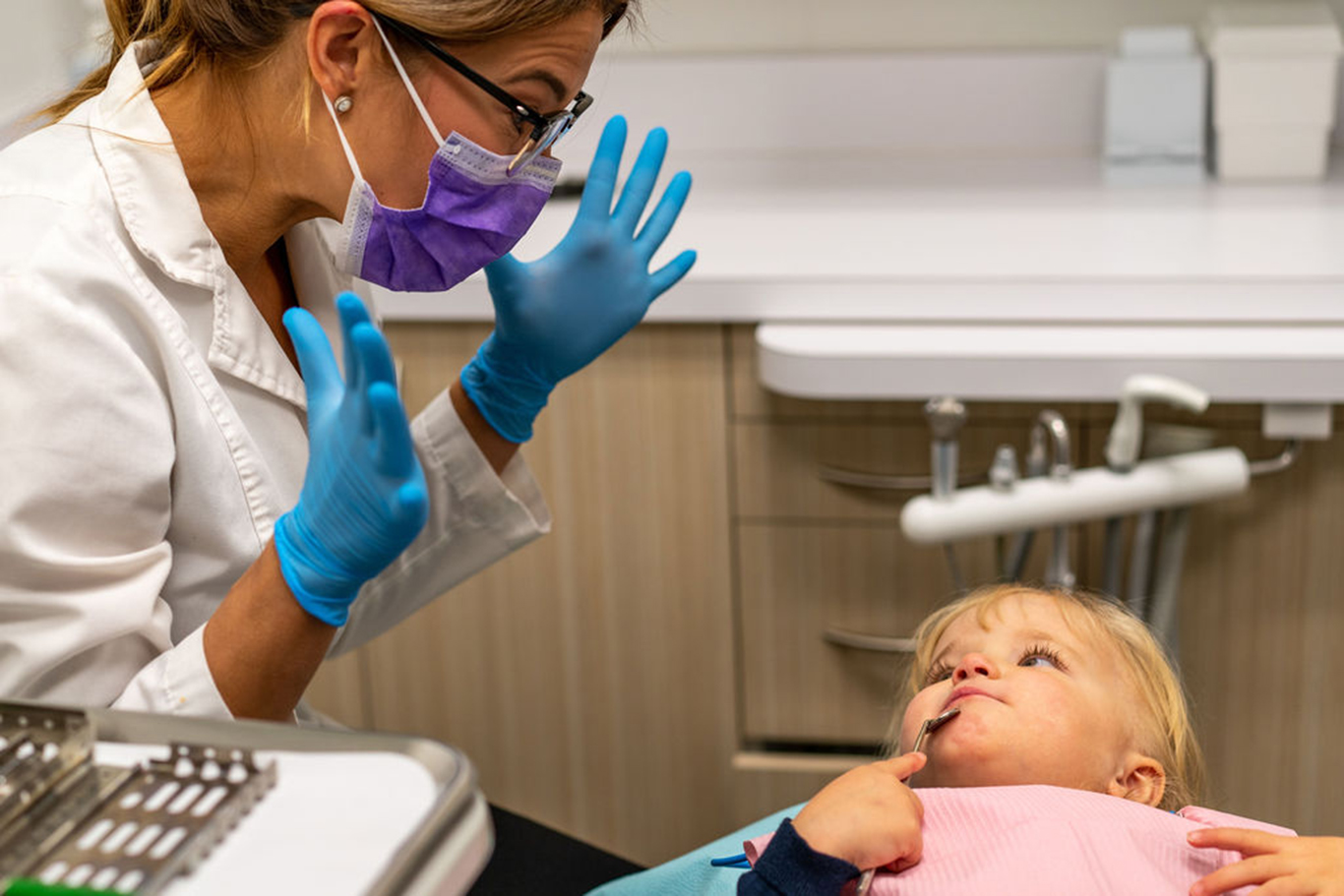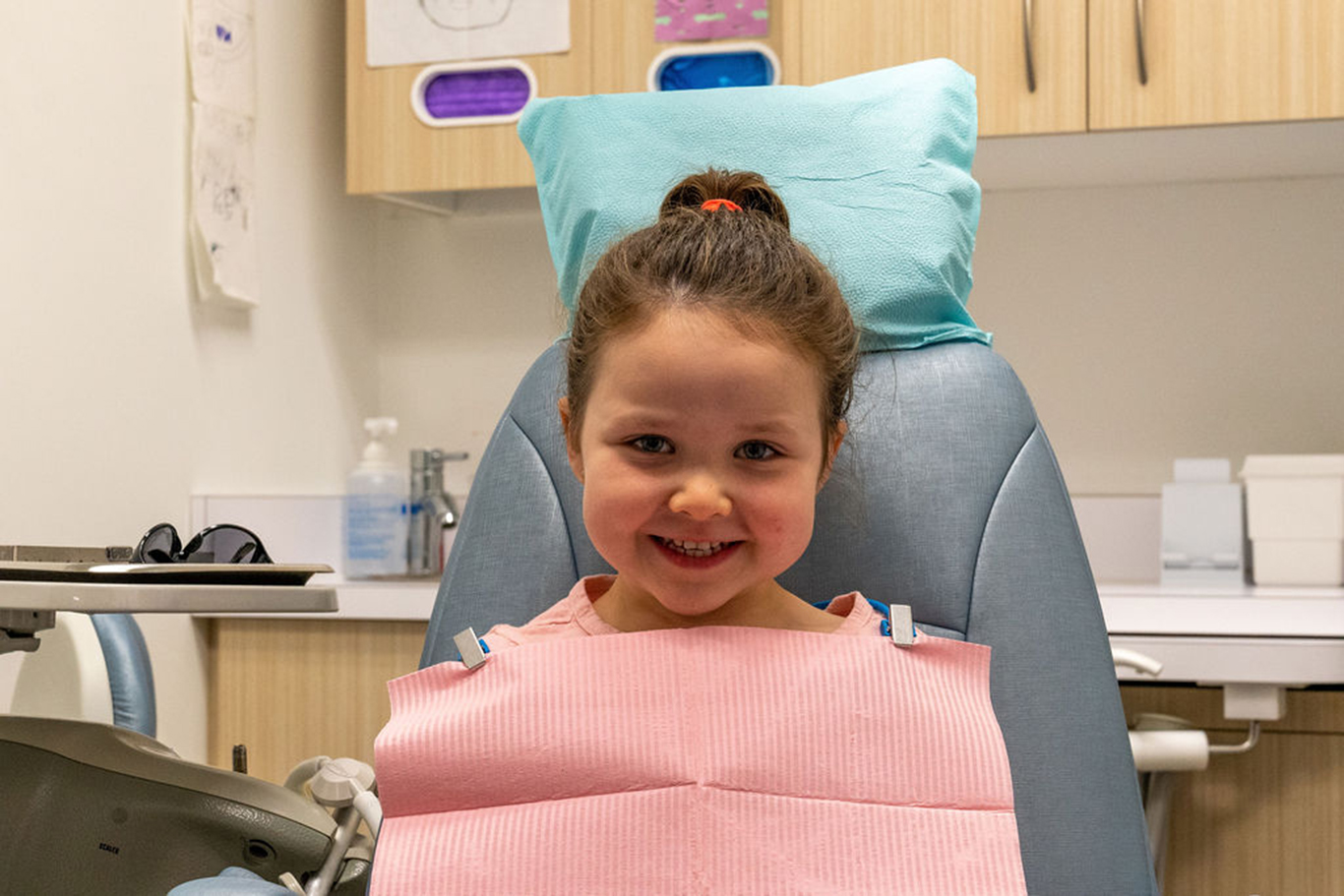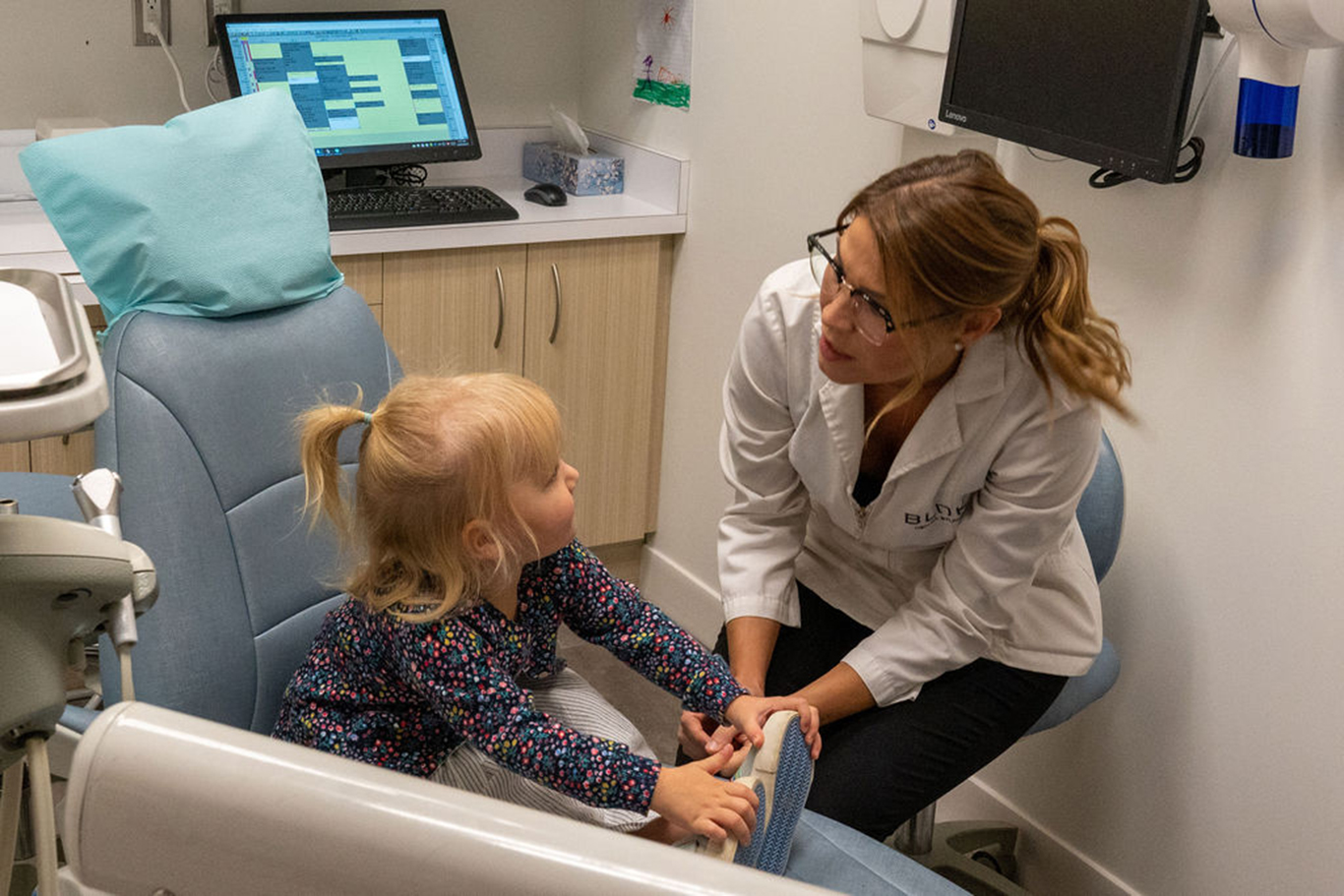Pediatric Dentistry
Dental Care For Kids
Dental Care For Kids
Starts With a Positive Experience
BLOK Dental Studio is a family friendly clinic with a dedicated play area and private animal-themed treatment room designed with our youngest patients in mind. We believe that it is very important to establish a positive dental experience from the very first visit to set up a lifetime of good oral health.
When Should Children Have Their First Dental Visit?
The Canadian Academy of Pediatric Dentistry (CAPD) suggests that parents make an initial “well-baby” appointment with a dentist approximately six months after the emergence of the first tooth, or no later than the child’s first birthday
Although this may seem surprisingly early, the incidence of infant and toddler tooth decay has been rising in recent years.
How can I prepare my child for their first visit to your clinic?
There are several things parents can do to make the first visit enjoyable. At a certain age, if the parent allows, the BLOK team likes to bring the child to the examination room on their own. We have a fun, colorful treatment room made for kids and really want to build a relationship of trust with our patients, as that is what creates a lifetime of comfort versus fear when visiting the dentist. Every child is different and the BLOK staff will do whatever is required to ensure both the parent and child are at ease.
Some helpful tips are listed below:
Leave other children at home – Other children can distract the parent and cause the infant to fuss. Leaving other children at home (when possible) makes the first visit less stressful for all concerned.
Avoid threatening language – our staff members are trained to avoid the use of threatening language, like drills, needles, injections, bleeding, etc. It is imperative for parents to use positive language when speaking about dental treatment with their child.
Provide positive explanations – It is important to explain the purposes of the dental visit in a positive way. For example, explaining that the dentist “helps to keep teeth healthy” is far better than explaining that the dentist “is checking for cavities, and may have to drill the tooth if decay is found.”
Explain what will happen – Anxiety can be vastly reduced if the child knows what to expect. Age-appropriate books about visiting the dentist can be very helpful in making the visit seem fun. Here is a list of parent and dentist-approved books:
- The Berenstain Bears Visit the Dentist – by Stan and Jan Berenstain.
- Show Me Your Smile: A Visit to the Dentist – Part of the “Dora the Explorer” Series.
- Going to the Dentist – by Anne Civardi.
- Elmo Visits the Dentist – Part of the “Sesame Street” Series.
What will happen during the first visit?
There are several goals for the first dental visit.
First, the dentist and the child need to get properly acquainted.
Second, the dentist needs to assess tooth eruption and the way the child’s teeth and jaws are fitting together in order to properly monitor growth and development.
Third, the dentist needs to evaluate the health of the existing teeth and gums.
Finally, the dentist aims to answer questions and advise parents on how to implement a good oral care regimen.
The following sequence of events is typical of an initial “well baby checkup”:
- Dental staff will greet the child and parents.
- The infant/family health history will be reviewed (this may include questionnaires).
- The dentist will address parental questions and concerns.
- The dentist will provide advice on good oral care.
- The infant’s teeth will be examined. Generally, the dentist and parent sit facing each other. The infant is positioned so that his or her head is cradled in the dentist’s lap. This position allows the infant to look at the parent during the examination.
- Proper brushing and flossing demonstrations will be provided.
- The state of the child’s oral health will be described in detail, and specific recommendations will be made. Recommendations usually relate to oral habits, appropriate toothpastes and toothbrushes for the child, orthodontically correct pacifiers, and diet.
- The dentist will detail which teeth may appear in the following months.
- The dentist will outline an appointment schedule and describe what will happen during the next appointment.
If you have questions or concerns about your child’s first dental visit, please contact us, one of our dental professionals will be more than happy to assist.
First visits can be stressful for parents, especially for parents who have dental phobias themselves. At BLOK Dental we suggest that parents continually communicate positive messages about dental visits to their children, and work to help them feel as happy and excited as possible about vising the dentist.
Proper Care For Your Child’s Teeth
Starts at Home
Oral care for kids has two main components: preventative care at the dentist’s office and preventative care at home. Though infant and toddler tooth decay have become increasingly prevalent in recent years, a good dental strategy will reduce the risk of oral disease.
The goal of preventative oral care is to evaluate and preserve the health of the child’s teeth. Beginning at the age of twelve months, BLOK Dental Studio follows the Canadian Dental Association (CDA) recommendations that children begin to visit their dentist for regular checkups. After that, we like to see them every six months.
How can I create good oral hygiene habits at home?
Though most parents primarily think of brushing and flossing when they hear the words “oral care,” good preventative care includes many more factors:
Diet – Parents should provide children with a nourishing, well-balanced diet. Very sugary diets should be modified, and continuous snacking should be discouraged. Oral bacteria ingest leftover sugar particles in the child’s mouth after each helping of food – emitting harmful acids that erode tooth enamel, gum tissue, and bone if left unchecked. Space out snacks where possible, and provide the child with non-sugary alternatives like celery sticks, carrot sticks, and low-fat yogurt.
Oral habits – Though pacifier use and thumb sucking generally cease over time, both can cause the teeth to misalign. If the child must use a pacifier, choose an “orthodontically correct” model. This will minimize the risk of developmental problems. Your BLOK Dental professional can suggest a strategy (or provide a dental appliance) for thumb sucking cessation.
General oral hygiene – Sometimes, parents cleanse pacifiers and teething toys by sucking them. Parents may also share eating utensils with the child. Harmful oral bacteria are transmitted from parent-to-child in these ways, increasing the risk of early tooth decay. Instead, rinse toys and pacifiers with warm water and avoid spoon-sharing wherever possible.
Sippy cup use – Sippy cups are an excellent aid to ease the transition from baby bottles to adult drinking glasses. However, sippy cups filled with milk, breast milk, soda, juice, and sweetened water cause small amounts of sugary fluid to continually swill around young teeth – meaning continuous acid attacks on tooth enamel. Sippy cup use should be terminated between the ages of twelve months and fourteen months – or whenever the child has the motor capabilities to hold a drinking glass.
Brushing – Children’s teeth should be brushed a minimum of two times per day using a soft bristled brush and a pea-sized amount of toothpaste. Parents should help with the brushing process until the child reaches the age of seven and is capable of reaching all areas of the mouth. Parents should always opt for CDA approved toothpaste (non-fluoridated before the age of two, and fluoridated thereafter). For babies, parents should rub the gum area with a clean cloth after each feeding.
Flossing – Cavities and tooth decay form more easily between teeth. Therefore, the child is at risk for cavities wherever two teeth grow adjacent to each other. The dentist can help demonstrate correct head positioning during the flossing process, and suggest tips for making flossing more fun!
If you have questions or concerns about how to care for your child’s teeth, please ask!
How will I know if my child has a cavity?
Large cavities can be excruciatingly painful, whereas tiny cavities may not be felt at all. Making matters even trickier, cavities sometimes form between the teeth, making them invisible to the naked eye. Dental x-rays and the dentist’s trained eyes help pinpoint even the tiniest of cavities so they can be treated before they worsen.
Some of the major symptoms of cavities include:
- Heightened sensitivity to cool or warm foods
- Nighttime waking and crying
- Pain
- Sensitivity to spicy foods
- Toothache
If a child is experiencing any of these symptoms, it is important to schedule a visit at BLOK at your earliest convenience. We don’t want the passage of time to make the problem worse, leave the child in pain, and possibly jeopardize a tooth that could have been treated.
Which toothpaste brand should I choose?
The most important consideration to make before implementing an oral care plan and choosing a toothpaste brand is the age of the child. Home oral care should begin before the emergence of the first tooth. A cool clean cloth should be gently rubbed along the gums after feeding to remove food particles and bacteria.
Prior to the age of two, the child will have many teeth and brushing should begin. Initially, select fluoride-free “baby” toothpaste and softly brush the teeth twice per day.
Between the middle and the end of the third year, select a Canadian Dental Association (CDA) accepted brand of toothpaste containing fluoride. The CDA logo is clear and present on toothpaste packaging, so be sure to check for it. Use only a tiny pea or rice-sized amount of fluoride toothpaste, and encourage the child to spit out the excess after brushing. Eliminating the toothpaste takes practice, patience, and motivation. If the child does ingest tiny amounts of toothpaste, don’t worry; this is perfectly normal and will cease with time and encouragement.
Dental fluorosis is not a risk factor for children over the age of eight, but a CDA accepted toothpaste is always the recommended choice for children of any age.
If you have questions or concerns about choosing an appropriate brand of toothpaste for your child, we will be happy to make recommendations.
How does diet affect my child's teeth?
Almost every snack contains at least one type of sugar. Most often, parents are tempted to throw away candy and chocolate snacks – without realizing that many fruit snacks contain one (if not several) types of sugar or carbohydrate. When sugar-rich snacks are eaten, the sugar content attracts oral bacteria. The bacteria feast on food remnants left on or around the teeth. Eventually, feasting bacteria produce enamel-attacking acids.
When tooth enamel is constantly exposed to acid, it begins to erode – the result is childhood tooth decay. If tooth decay is left untreated for prolonged periods, acids begin to attack the soft tissue (gums) and even the underlying jawbone. Eventually, the teeth become prematurely loose or fall out, causing problems for emerging adult teeth – a condition known as childhood periodontal disease.
Regular checkups and cleanings at the dentist’s office are an important line of defense against tooth decay. However, implementing good dietary habits and minimizing sugary food and drink intake as part of the “home care routine” are equally important.
Fluoride
One of the most common questions we get about oral health is around the use of fluoride. Fluorine, a natural element in the fluoride compound, has proven to be effective in minimizing the incidence of tooth decay.
Fluoride is a key ingredient in many popular brands of toothpaste, oral gel, and mouthwash, and can also be found in most community water supplies. Though fluoride is an important part of any good oral care routine, overconsumption can result in a condition known as fluorosis.
We recommend that children under the age of two use a fluoride-free toothpaste. Simply because up to that age, they may not understand that they can’t swallow the toothpaste. While ingesting a small amount of fluoride is not harmful, we suggest waiting until your child can spit out the toothpaste after brushing. Around the age of two, or whenever they are able to spit out the toothpaste, using a very small (pea-sized) amount of fluoridated toothpaste is a good start.
How can fluoride prevent tooth decay?
Fluoride fulfills two important dental functions. First, it helps to staunch mineral loss from tooth enamel, and second, it promotes the remineralization of tooth enamel.
When carbohydrates (sugars) are consumed, oral bacteria feed on them and produce harmful acids. These acids attack tooth enamel – especially in children who take medications or produce less saliva. Repeated acid attacks result in tooth decay and childhood periodontal disease. Fluoride protects tooth enamel from acid attacks and reduces the risk of childhood tooth decay.
Fluoride is especially effective when used as part of a good oral hygiene regimen. Reducing the consumption of sugary foods, brushing and flossing regularly, and visiting the dentist biannually, all supplement the work of fluoride and keep young teeth healthy.
How much fluoride is enough?
Since community water supplies and toothpastes usually contain fluoride, it is essential that children do not ingest too much. For this reason, children under the age of two should use a CDA approved, non-fluoridated brand of toothpaste. Children between the ages of two and five years old should use a pea-sized amount of CDA approved fluoridated toothpaste on a clean toothbrush twice each day. They should be encouraged to spit out any extra fluid after brushing. This part might take time, encouragement, and practice.
The amount of fluoride children ingest between the ages of one and four years old determines whether or not fluorosis occurs later. The most common symptom of fluorosis is white specks on the permanent teeth. Children over the age of eight years old are not considered to be at risk for fluorosis but should still use an CDA approved brand of toothpaste.
Does my child need fluoride supplements?
Your dentist is the best person to decide whether a child needs fluoride supplements. First, the dentist will ask questions in order to determine how much fluoride the child is currently receiving, gain a general health history, and evaluate the sugar content in the child’s diet. If a child is not receiving enough fluoride and is determined to be at high risk for tooth decay, an at-home fluoride supplement may be recommended.
Topical fluoride can also be applied to the tooth enamel quickly and painlessly during a regular office visit. There are many convenient forms of topical fluoride, including foam, liquids, varnishes, and gels. Depending on the age of the child and their willingness to cooperate, topical fluoride can either be held on the teeth for several minutes in specialized trays or painted on with a brush.
If you have questions or concerns about fluoride or fluorosis, please contact us.
Sealing Out Tooth Decay
Dental sealants are an important tool in preventing childhood tooth decay. When used in combination with other preventative measures such as routine checkups and an excellent daily home care routine, sealants can bolster the mouth’s natural defenses, and keep smiles healthy.
How do sealants protect children’s teeth?
Dental sealants are used to protect molars from oral bacteria and acids that can damage the teeth. These larger, flatter teeth reside toward the back of the mouth and can be difficult to clean. Molars are typically where four out of five instances of tooth decay occur. Decay-causing bacteria often inhabit the deep grooves found on the chewing surfaces of the molars. These areas are extremely difficult to access with a regular toothbrush.
Dental sealants do not enhance the health of the teeth directly, and are not intended to be a substitute for general oral care. Sealants are less costly, less uncomfortable, and more aesthetically pleasing than dental fillings.
How are sealants applied?
Though there are many different types of dental sealants, most are comprised of liquid plastic. Initially, the dentist must thoroughly clean and prepare the molars before painting sealant on the targeted teeth.
When every targeted tooth is coated to the dentist’s satisfaction, the sealant is either left to self-harden or exposed to blue spectrum natural light for several seconds (depending on the chemical composition of the specific brand). This specialized light works to harden the sealant and cure the plastic. The final result is a white layer of thin, hard, durable sealant.
It should be noted that the “sealing” procedure is easily completed in one office visit and is entirely painless.
When should sealants be applied?
Sealants are usually applied when the primary molars first emerge. Depending on the oral habits of the child, the sealants may last for the life of the tooth or need replacing several times. Essentially, sealant durability depends on the oral habits of the individual child.
We will monitor the sealant at regular appointments. If the seal begins to lift off, food particles may become trapped against the tooth enamel and can lead to tooth decay.



